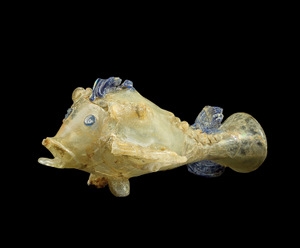Today, Barbara and I went to the Musée des Civilisations to find some of the hidden treasures that had been brought there from Afghanistan. We did not expect to find such a variety.
The richest part of Afghanistan from a cultural point of view seems to have been the Hindu Kush in the mountainous north east of the country, through which the Silk Road ran. Along it came itinerant merchants from China and Mongolia in the east, also from Persia, Mesopotamia and India, and from what is now Turkey and Greece in the west; they brought their artifacts with them and deposited them in various places along the way. From the west they carried glass and bronzes; from the central countries precious stones (rubies, garnets, lapis lazuli) and Persian carpets. Horses from Siberia, ivory from India, silk from China.
At one time northeastern Afghanistan was known as Bactria, colonised by followers of Alexander the Great; they founded the city of Ai-Khanum (meaning "Lady Moon") around 300 BC, building imposing Grecian columns topped with stone capitals which were later toppled by the Mongolian hordes under Genghis Khan. The central edifice was a temple, perhaps to Zeus, with images of the (Phrygian) Goddess of Nature, Cybele, besides. Among the exhibits in the hall showing Ai-Khanum was an animated model of the temple shown on a screen, computer generated ghosts wandering about in it. They had stone sundials, some of them almost identical to ancient sundials from Italy or Grecian Egypt; others were apparently Indian in design. Beautifully coloured ointment bowls were on display as well.
Two thousand years before Ai-Khanum, in the Bronze or "Oxus" Age the area was Mesopotamian and golden bulls with beards have been unearthed to prove it.
 Bagram was another such city, where an astonishing cache of treasures was discovered, Chinese, Indian, Egyptian and Roman, presumably either made by itinerant craftsmen or transported from those parts of the world. The cache had been bricked up and sealed in an underground storage room in the foothills of spectacular, pointed mountains. A few items—Chinese laquer ware and ostrich eggs—were too fragile to be displayed in this exhibition, but we did get to see the alabaster dishes and amphorae, and the wonderful glass-blown fish. The fish are presumed to have been vessels for cosmetics; glass blowing had begun in Egypt around 1500 BC. There were goblets from Roman Egypt too, painted with animals and people and plaster medallions, moulds from Roman silverware, perhaps intended as samples to be shown to buyers.
Bagram was another such city, where an astonishing cache of treasures was discovered, Chinese, Indian, Egyptian and Roman, presumably either made by itinerant craftsmen or transported from those parts of the world. The cache had been bricked up and sealed in an underground storage room in the foothills of spectacular, pointed mountains. A few items—Chinese laquer ware and ostrich eggs—were too fragile to be displayed in this exhibition, but we did get to see the alabaster dishes and amphorae, and the wonderful glass-blown fish. The fish are presumed to have been vessels for cosmetics; glass blowing had begun in Egypt around 1500 BC. There were goblets from Roman Egypt too, painted with animals and people and plaster medallions, moulds from Roman silverware, perhaps intended as samples to be shown to buyers.
We were intrigued by the ivory models of mythical beasts, such as the leogryph (ridden by a voluptuous woman) with its lion's body, eagle's wings and the beak of a parrot. Likewise there was the makara, the beast traditionally ridden by the goddess Ganga, part crocodile, part elephant, part fish. Most fascinating were the three ivory table legs in the form of three women, two of them (partly) dressed in Indian garb, but the third in a Grecian robe.
The most spectacular of the exhibition rooms was the one showing the finds at Tillya Tepe, from the tombs of a tall nomadic chieftain (1.8 m) and his five wives, perhaps sacrificed at the time of his burial along with his horse. The horse's skeleton was alongside, anyhow. These tombs were full of golden jewellery mostly set with turquoise or lapis lazuli, although there was also a stunning collection of hair pendants (sic) and a headdress ornament shaped like a tree, hung with tiny pearls. Headdresses seem to have been the women's crowning glory and there was indeed a proper crown, but collapsible—hinged in sections for ease of packing in a saddle bag. Its golden leaves would have rustled in the breeze, interspersed with flowers with silver centres. A miniature ram was found, made of pure gold, another headdress adornment.
All these treasures are the property of the National Museum in Kabul which was bombed and looted by the Soviets. Fortunately in 1978 someone had had the foresight to remove the most portable artefacts to a hiding place in the Presidential Palace, so these were saved from destruction. The vault was re-opened in 2003. Afghanistan is still not exactly a safe country, but the people have access to their treasures. On more than one wall of the exhibition halls was written:
A nation stays alive when its culture stays alive.

No comments:
Post a Comment